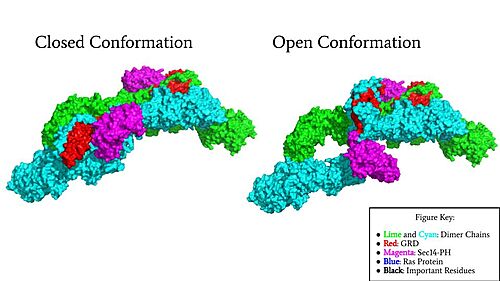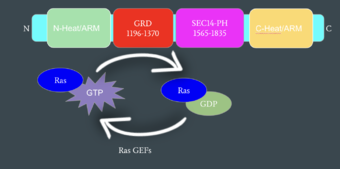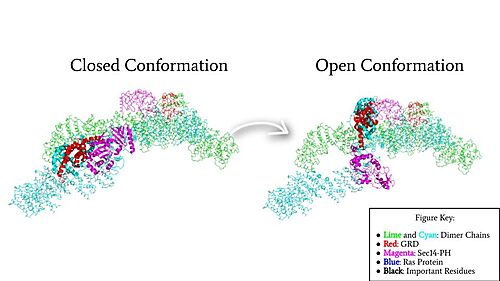Sandbox Reserved 1710
From Proteopedia
(Difference between revisions)
| Line 30: | Line 30: | ||
== Conformational States == | == Conformational States == | ||
| - | === Closed Conformation | + | === Closed Conformation === |
In the <scene name='90/904315/Closed/3'>closed, inactive conformation</scene>, the GRD and Sec14-PH domains are rotated so Ras cannot bind. In this conformation, the GRD and Sec14-PH are inaccessible and inactive. Neurofibromin is held in the inactive state by a <scene name='90/904315/Closed_triade/2'>triad</scene> consisting of residues Cys 1032, His 1558, and His 1576 that form a transition metal-binding site with zinc. The rigid organization of the <scene name='90/904315/Catalytic_triade/3'>triad in closed conformation</scene> keeps the GRD domain packed tightly on top of the Heat Arms in the Neurofibromin core. This tight compaction sterically occludes Neurofibromin from associating with Ras. In its active form, Ras and Neurofibromin will associate via an <scene name='90/904316/Arg_finger/2'>Arginine finger</scene> (Arg 1276). However, the steric hindrance from the Neurofibromin core in the closed conformation inhibits this association. Therefore, in the closed conformation, neurofibromin cannot catalyze GTP hydrolysis by Ras and Ras continues to signal for cell growth and proliferation. | In the <scene name='90/904315/Closed/3'>closed, inactive conformation</scene>, the GRD and Sec14-PH domains are rotated so Ras cannot bind. In this conformation, the GRD and Sec14-PH are inaccessible and inactive. Neurofibromin is held in the inactive state by a <scene name='90/904315/Closed_triade/2'>triad</scene> consisting of residues Cys 1032, His 1558, and His 1576 that form a transition metal-binding site with zinc. The rigid organization of the <scene name='90/904315/Catalytic_triade/3'>triad in closed conformation</scene> keeps the GRD domain packed tightly on top of the Heat Arms in the Neurofibromin core. This tight compaction sterically occludes Neurofibromin from associating with Ras. In its active form, Ras and Neurofibromin will associate via an <scene name='90/904316/Arg_finger/2'>Arginine finger</scene> (Arg 1276). However, the steric hindrance from the Neurofibromin core in the closed conformation inhibits this association. Therefore, in the closed conformation, neurofibromin cannot catalyze GTP hydrolysis by Ras and Ras continues to signal for cell growth and proliferation. | ||
| - | === Open Conformation | + | === Open Conformation === |
In the <scene name='90/904315/Open_conformation/4'>open, active conformation</scene>, (REWRITE ABOUT RAS REGULATION) | In the <scene name='90/904315/Open_conformation/4'>open, active conformation</scene>, (REWRITE ABOUT RAS REGULATION) | ||
| Line 43: | Line 43: | ||
== Disease and Medical Relevance == | == Disease and Medical Relevance == | ||
| - | Currently over 1485 mutations of Neurofibromin have been identified that lead to life-threatening illnesses or conditions such as Neurofibromatosis Type I.<ref name="Lupton">PMID: 34887559 </ref> Mutations to the NF1 gene that prevent the interaction of Neurofibromin with Ras, remove this check on Ras dependent cell proliferation and uncontrolled cell growth can lead to tumors and a higher risk of cancer. [https://en.wikipedia.org/wiki/Neurofibromatosis_type_I Neurofibromatosis Type 1], the most well-known disease resulting from mutations in Neurofibromin, is characterized by cognitive impairment, soft, non-cancerous tumors on or under the skin known as neurofibromas, birthmarks called [https://en.wikipedia.org/wiki/Caf%C3%A9_au_lait_spot cafe-au-lait macules], clusters of freckles in unusual places, and problems with the bones, eyes and nervous system. | + | Currently over 1485 mutations of Neurofibromin have been identified that lead to life-threatening illnesses or conditions such as Neurofibromatosis Type I.<ref name="Lupton">PMID: 34887559 </ref> Mutations to the NF1 gene that prevent the interaction of Neurofibromin with Ras, remove this check on Ras-dependent cell proliferation and uncontrolled cell growth can lead to tumors and a higher risk of cancer. [https://en.wikipedia.org/wiki/Neurofibromatosis_type_I Neurofibromatosis Type 1], the most well-known disease resulting from mutations in Neurofibromin, is characterized by cognitive impairment, soft, non-cancerous tumors on or under the skin known as neurofibromas, birthmarks called [https://en.wikipedia.org/wiki/Caf%C3%A9_au_lait_spot cafe-au-lait macules], clusters of freckles in unusual places, and problems with the bones, eyes and nervous system. |
Neurofibromin is also involved in the differentiation of [https://en.wikipedia.org/wiki/Neural_crest neural crest-derived cells], [https://en.wikipedia.org/wiki/Mesenchymal_stem_cell mesenchymal cells], [https://en.wikipedia.org/wiki/Neural_stem_cell neural cells], [https://en.wikipedia.org/wiki/Melanocyte melanocytes], and [https://en.wikipedia.org/wiki/Osteocyte bone cells]. As Neurofibromin is essential for embryonic development, mutations to the NF1 gene can result in psychological retardation resulting from Type I neurofibromatosis. Most of the 1485 point mutations identified lead to a synthesis of truncated, non-functional protein. Type I Neurofibromatosis is inherited in an autosomal dominant manner but about 50% of cases result from de novo mutations. <ref name="Abramowicz">PMID:25182393</ref> | Neurofibromin is also involved in the differentiation of [https://en.wikipedia.org/wiki/Neural_crest neural crest-derived cells], [https://en.wikipedia.org/wiki/Mesenchymal_stem_cell mesenchymal cells], [https://en.wikipedia.org/wiki/Neural_stem_cell neural cells], [https://en.wikipedia.org/wiki/Melanocyte melanocytes], and [https://en.wikipedia.org/wiki/Osteocyte bone cells]. As Neurofibromin is essential for embryonic development, mutations to the NF1 gene can result in psychological retardation resulting from Type I neurofibromatosis. Most of the 1485 point mutations identified lead to a synthesis of truncated, non-functional protein. Type I Neurofibromatosis is inherited in an autosomal dominant manner but about 50% of cases result from de novo mutations. <ref name="Abramowicz">PMID:25182393</ref> | ||
Revision as of 17:39, 12 April 2022
| This Sandbox is Reserved from February 28 through September 1, 2022 for use in the course CH462 Biochemistry II taught by R. Jeremy Johnson at the Butler University, Indianapolis, USA. This reservation includes Sandbox Reserved 1700 through Sandbox Reserved 1729. |
To get started:
More help: Help:Editing |
Human Neurofibromin - The Tumor Suppressor Gene
| |||||||||||
References
- ↑ Naschberger A, Baradaran R, Rupp B, Carroni M. The structure of neurofibromin isoform 2 reveals different functional states. Nature. 2021 Nov;599(7884):315-319. doi: 10.1038/s41586-021-04024-x. Epub 2021, Oct 27. PMID:34707296 doi:http://dx.doi.org/10.1038/s41586-021-04024-x
- ↑ Trovo-Marqui AB, Tajara EH. Neurofibromin: a general outlook. Clin Genet. 2006 Jul;70(1):1-13. doi: 10.1111/j.1399-0004.2006.00639.x. PMID:16813595 doi:http://dx.doi.org/10.1111/j.1399-0004.2006.00639.x
- ↑ Lupton CJ, Bayly-Jones C, D'Andrea L, Huang C, Schittenhelm RB, Venugopal H, Whisstock JC, Halls ML, Ellisdon AM. The cryo-EM structure of the human neurofibromin dimer reveals the molecular basis for neurofibromatosis type 1. Nat Struct Mol Biol. 2021 Dec;28(12):982-988. doi: 10.1038/s41594-021-00687-2., Epub 2021 Dec 9. PMID:34887559 doi:http://dx.doi.org/10.1038/s41594-021-00687-2
- ↑ Abramowicz A, Gos M. Neurofibromin in neurofibromatosis type 1 - mutations in NF1gene as a cause of disease. Dev Period Med. 2014 Jul-Sep;18(3):297-306. PMID:25182393
- ↑ Ratner N, Miller SJ. A RASopathy gene commonly mutated in cancer: the neurofibromatosis type 1 tumour suppressor. Nat Rev Cancer. 2015 May;15(5):290-301. doi: 10.1038/nrc3911. Epub 2015 Apr 16. PMID:25877329 doi:http://dx.doi.org/10.1038/nrc3911




